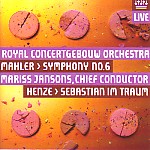As a telling illustration of the classical music industry’s determination to render new recordings of major works completely valueless, I offer as Exhibit A the present Mahler Sixth. Just recently, the LSO released its version of this very work, under this very conductor. Now that orchestras are offering their own productions to the public, get ready for more of the same as conductors and soloists make the rounds of the world’s concert venues, spewing recordings in their wake. Do you think anyone will have the intelligence to make sure that their offerings are genuinely unique? Do you think artists will have the self-discipline to select only what they deem to be their finest effort and refuse permission to release any others? Here we have the answer, and even if this were a much better Mahler Sixth (and it is in fact slightly superior to the LSO rendition), who cares? It’s a clear matter of been there, heard that.
Specifically, Jansons leads a clean, respectful performance characterized by judiciously chosen tempos and firm rhythm. Moments such as the “Alpine meadow” episode in the Andante (here placed second, alas) come across more atmospherically than before. Unlike the LSO performance, the brass–trombones and horns particularly–are less prominent, even to the point of reticence. But they do rise to the big moments–and speaking of which, the hammer blows are terrific. Also as before, there’s little sense of menace to the opening march, minimal grotesquerie in the scherzo, and no terror to the opening of the finale. The playing has a certain softness partly attributable to the Concertgebouw acoustic, partly due to Jansons evidently being satisfied with greater homogeneity of ensemble sound than he got in London. The woodwinds, as expected, are marvelous.
But for all that this is a decent, well-engineered performance, you can have this same orchestra in this same symphony under Chailly on Decca in an absolutely stunningly played and recorded outing, sporting an interpretation of far greater interest and personality. Amid a plethora of Mahler Sixths featuring either Jansons or the Concertgebouw, only the very hardest of hard-core collectors could possibly be expected to want this one. And believe me, the coupling is no bonus.
Sebastian im Traum is a three-movement “Nachtmusik” (inspired by a poem by Georg Trakl) in which the occasional attractive sonority or hint of melody only serves to emphasize the vacuousness of the rest. Henze is an artist whose style (Berg with an attitude?) has dated badly, to the point where he sometimes sounds like a caricature of a post-War German composer. I suppose the performance is marvelous, but again, who cares?
Please understand: I love Mahler; I love this symphony. I’ve played it many times, and I own just about every recording ever made of it. I don’t want readers to get the impression that I’ve become jaded. All it takes is a great performance to make the music sound like new. The problem starts with the unending deluge of merely good interpretations: solid, professional, reliable, and ultimately boring. What ought to be momentous has become about as ordinary (and valuable) as your morning newspaper. Some days it’s interesting, but most of the time it’s not. And quite often, you just leave it on your front porch and try not to trip over it on your way out of the house. So here is Jansons’ second recording of the Sixth in about a year–and what? the third or fourth by the Concertgebouw? Watch your step as you leave.
































